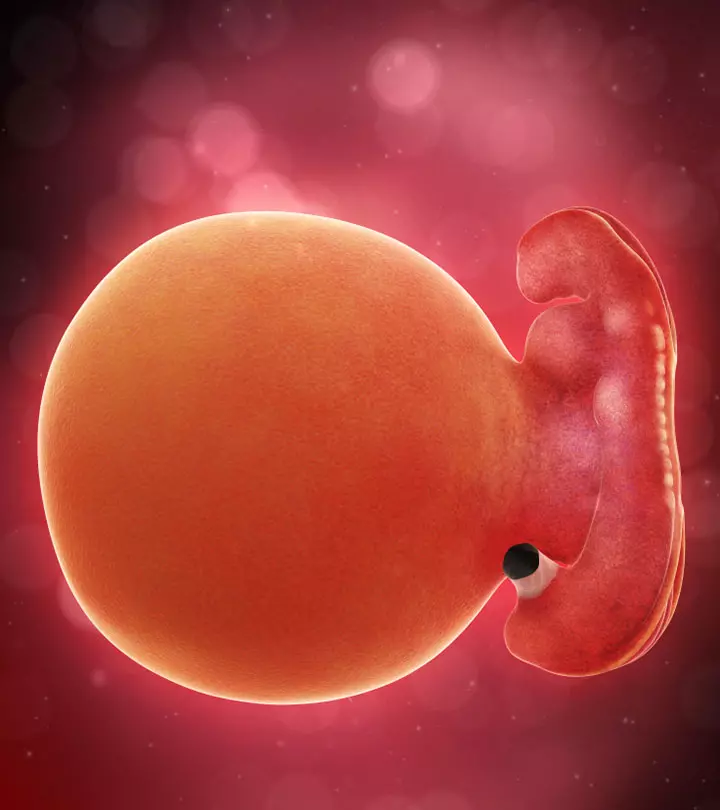
Image: iStock
Urinalysis is a part of the routine prenatal tests to diagnose any medical condition during pregnancy, including kidney infections, preeclampsiaiA pregnancy disorder characterized by high blood pressure, water retention, and protein content in urine. , and gestational diabetesiA condition characterized by elevated blood sugar levels due to hormonal and physical changes in pregnancy.

. It also detects the increase of leukocytes in urine during pregnancy, which may indicate the presence of any infection or inflammation of the genitourinary or urinary tract. You may also need the urinary test to check the functioning of the maternal organs (1) (2).
Read on to know the causes, risk factors, symptoms, diagnosis, treatment management, and preventive measures for leukocytes or white blood cells (WBCs) in urine when pregnant.
Key Pointers
- Leukocytes in pregnant women’s urine may indicate a urinary tract infection or inflammation.
- Frequent urination, an urgency to pee, pain in the pubic area, foul-smelling urine, etc., are some symptoms of leukocytes (WBC) in the urine.
- Natural foods such as cranberries, garlic, probiotics, etc., may help treat mild urine infections.
What Are Leukocytes In Urine?
Leukocytes or WBCs are a part of your immune system and include granulocytes (neutrophils, eosinophils, and basophils), monocytes, and lymphocytes (T cells and B cells). Together, these WBCs help the body fight infections and other diseases.
In general, measuring the leukocyte count is a part of a complete blood cell count (CBC) test (3). However, if urinary tract infections (UTIs) or inflammation are suspected during routine prenatal testing, your health care provider may suggest a urine test to detect the presence of leukocytes (particularly neutrophils). Normally, urine is sterile, so the normal range of leukocytes in urine is low, i.e., up to 5 WBCs per high power field (WBC/HPF) (4).
According to Dr. Alan Lindemann, obstetrician, who was also a former clinical associate professor at the University of North Dakota, Grand Forks, “Leukocytes are elevated in blood and urine during pregnancy, but the normal depends on where you start. If your non-pregnant WBC is 5000, then a WBC of 10,000 or 11,000 is probably normal for pregnancy, but if you start your pregnancy with a higher WBC, normal for you could rise to 15,000.
“A urine WBC might not signify a bladder infection, but it could forecast trouble. An elevated WBC could represent a Group B strep infection, so a urine culture is needed because a Group B strep bladder infection can cause kidney infection and preterm labor or birth.”
Causes Of Leukocytes In Urine During Pregnancy
During pregnancy, elevated levels of leukocytes in urine may occur due to various infections, including
- Urinary tract infection: UTIs are already common in women and its probability increases by 8% during pregnancy, and it is mostly caused by Escherichia coli. The decreased ability of the lower urinary tract to resist invading bacteria during pregnancy contributes to the development of UTI during pregnancy. Subsequently, the leukocyte count in urine increases to fight off this infection (5).
- Asymptomatic bacteriuria: According to a study by University Hospitals of Geneva, asymptomatic bacteriuria affects 2% to 7% of pregnant women. This UTI causes a bacterial infection without symptoms, causing leukocytes to appear in the urine. Untreated asymptomatic bacteriuria can be life-threatening as it can lead to pyelonephritis (kidney infection) and affect the fetus. Therefore, it is recommended to do repeated urine cultures or urine dipstick leukocyte esterase tests (a faster screening method) during pregnancy to measure the leukocyte level (6).
- Genital infections: Certain genital infections, including bacterial vaginosisiA common vaginal infection caused due to overgrowth of bacteria that are naturally found in the vagina. , vaginitisiInflammation of the vagina. , and vaginal yeast infection, are common during pregnancy. They are mainly caused by hormonal changes and can lead to pyuria (causing leukocytes in urine) (6) (7).
- Pyelonephritis: It may develop when a UTI or asymptomatic bacteriuria is untreated during pregnancy. It is a severe systemic kidney infection that can cause high amounts of leukocytes in the urine and have negative pregnancy outcomes (5) (6) (8).
 Quick fact
Quick fact- Cystitis (bladder inflammation): This UTI affects around 1% of all pregnancies. It is differentiated from asymptomatic bacteriuria by symptoms such as dysuria, urine urgency or frequency, and suprapubic pain (pain in the lower abdomen) without evidence of systemic illness. Since it causes elevated WBC levels in the urine, a urinalysis is used to diagnose it in pregnancy (9) (10).
- Trichomoniasis: Although uncommon in pregnancy, this sexually transmitted infection (STI) may cause excess WBCs in the urine due to inflammation (11) (12).
Symptoms Of White Blood Cells In Urine When Pregnant
The symptoms of WBCs or leukocytes in the urine samples of pregnant women may vary depending on the underlying cause. Some of these symptoms include (13) (14)
- Dysuria (pain or burning while urinating)
- Frequent urination
- Urine urgency
- Suprapubic pain
- Foul-smelling urine
- Flank pain or renal angle (lower back) pain
- Rigor
- Fever (pyrexia)
- Nausea and vomiting

Image: Shutterstock
Diagnosis Of Leukocytes In Urine During Pregnancy
Dr. Lindemann observes, “There are two ways to check for leukocytes in urine during pregnancy: a clean catch urine sample or sterile catheterization. With more vaginal discharge in pregnancy, sterile catheterization is the most accurate test for leukocytes during pregnancy.”
The following diagnostic methods can be used to detect leukocytes in urine (14):
- Leukocyte esterase urine dipstick test: Increased WBCs or leukocytes in the urine sample of a pregnant woman can be diagnosed using a leukocyte esterase urine dipstick test. The procedure includes (1) (15) (16)

Image: Shutterstock
- Collection of the urine sample: Generally, a clean-catch urine sample is recommended. Your doctor may provide a clean-catch kit with a washing solution and sterile wipes, or you may be asked to collect a small sample of clean, midstream urine in a sterile plastic cup.
- Urine dipstick test: Your health care provider may test the sample right after the urine sample collection. Chemically prepared testing strips of leukocyte esterase with a color-sensitive pad are dipped into your urine sample to screen for indicators such as leukocytes.
 Quick fact
Quick fact- Positive test: If the strip changes color within 30 seconds to two minutes (depending on the brand), it is taken as a positive test, suggesting infection or inflammation in the urinary tract.
- Negative test: If the strips show no color change, your urine sample may not have a significant amount of leukocytes. However, high protein and vitamin C levels in the urine or specimen contamination with vaginal secretions may interfere with the result. In such cases, your doctor may recommend a urine culture if you have other symptoms suggestive of UTI.
- Microscopic urinalysis: If your leukocyte esterase urine dipstick test is positive, a microscopic examination of the urine and urine culture and sensitivity are performed to determine the WBC level and check for indicators of infection.
The urine sediment of a fresh urine sample is centrifuged at 1,500 to 3,000 rpm for five minutes and resuspended in the remaining liquid for analysis
. A single drop is deposited on a clean glass slide, covered with a coverslip, and viewed under a microscope.
 Point to consider
Point to consider- Urinary leukocyte cast: They can be used to identify the location of the illness in the genitourinary tract.
Treatment Of Elevated White Blood Cells In Urine During Pregnancy
The treatment options may vary depending on the cause and elevation level of leukocytes in the urine. Some standard treatment methods that may be included in your prenatal care regime to help balance or decrease the levels of leukocytes in urine during pregnancy are
- Antibiotic therapy: Almost all the conditions causing elevated leukocytes in urine during pregnancy can be managed with appropriate antibiotic treatment. However, certain antibiotics, such as fluoroquinolones, are contraindicated during pregnancy. Hence, consult an obstetrics and gynecology specialist before taking any antibiotics (17).
- Natural remedies: Consumption of cranberries, garlic, probiotics, parsley, L-arginine supplements, and sufficient water can help treat UTI and other urinary tract infections during pregnancy (18). However, consult a healthcare provider before starting any natural remedies to ensure they are safe for you and your baby.

Image: IStock
Complications Of Elevated White Blood Cells In Urine During Pregnancy
Treatment should be initiated soon after a high level of leukocytes is detected in urine samples to prevent adverse obstetrical outcomes
. Some of the maternal complications include (10)
- Preeclampsia
- Anemia
- Preterm delivery
- Maternal sepsisiA fatal illness in mothers defined by organ dysfunction due to an infection during pregnancy, abortion, childbirth, or postpartum.
- Chorioamnionitis (bacterial infection in the membranes surrounding the fetus)
It can also cause the following complications in the fetus and affect fetal development (20):
- Low birth weight
- TachycardiaiIncreased heartbeat (more than 100 beats per minute).
- Premature birth

Image: Shutterstock
- Growth restriction
- Stillbirth
- Perinatal mortalityiA term used to describe infant deaths between 28 weeks of pregnancy and less than seven days after birth.
- Mental retardation
- Developmental delay
Prevention Of Elevated White Blood Cells In Urine During Pregnancy
Here are some tips that may help prevent elevated leukocytes in the urine and improve maternal health (13) (18):
- Do regular urine tests as suggested by your doctor to prevent recurrent infections
- Drink plenty of water
- Consume cranberry juice and supplements

Image: IStock
- Maintain good hygiene practices, such as wiping from front to back after a bowel movement
- Avoid synthetic and tight-fitting lingerie
- Avoid perfumed genital washing gels
Frequently Asked Questions
1. Can I have leukocytes in urine without infection?
Yes. Normally, you may have 0–5 WBC/HPF in your urine even when pregnant. However, if the level exceeds 5 WBC/HPF, it may be a sign of infection or inflammation in the urinary tract, and treatment may be required (4).
2. Can leukocytes in urine cause fetal death if left untreated?
Yes. Other than UTI, increased leukocytes in the urine of a pregnant woman may be due to cystitis, pyelonephritis, or various genital infections, which increase the risk of a fatal complication in the fetus. However, fetal death is rare in such cases (10).
3. Can leukocytes in urine be serious in pregnancy?
The presence of excess leukocytes for too long in the urine may indicate a severe underlying infection. Severe infections may also lead to other symptoms. Therefore, prompt treatment is vital to avoid adverse maternal and fetal health effects.
High levels of leukocytes in urine during pregnancy may occur due to different infections caused by bacteria or fungi. The symptoms of high leukocyte levels depend on the underlying cause but may include frequent urination, fever, and nausea. This condition is usually detected during the routine urine tests conducted in pregnancy, following which you may be prescribed antibiotics or home remedies, depending on the cause and severity. Hence, the condition is manageable with timely and effective medical intervention. However, delay in treatment may lead to an extreme increase in leukocytes, which can lead to complications.
Infographic: Indicators And Underlying Causes Of Urinary Leukocytes During Pregnancy
The presence of increased leukocytes in urine during pregnancy indicates an underlying infection. Identifying early symptoms and the underlying causes are crucial for appropriate management. Let’s look at the infographic below, as it explains various possible symptoms and causes of urinary leukocytes during pregnancy.
Some thing wrong with infographic shortcode. please verify shortcode syntax
Illustration: Leukocytes In Urine During Pregnancy: Causes And Treatment

Image: Dalle E/MomJunction Design Team
Uncover the potential resons behind the presence of high WBCs in urine during pregnancy and when to consult the doctor about it
References
- Getting a Pregnancy Urinalysis: About Prenatal Urine Tests.
https://americanpregnancy.org/prenatal-testing/urine-test-urinalysis/ - Microscopic Urinalysis.
https://www.urmc.rochester.edu/encyclopedia/content?contenttypeid=167&contentid=urinanalysis_microscopic_exam - Leukocyte.
https://www.cancer.gov/publications/dictionaries/cancer-terms/def/leukocyte - Karen M. Ringsrud; (2001); Cells in the Urine Sediment.
https://academic.oup.com/labmed/article/32/3/153/2504199 - John E. Delzell J. R. and Michael L. Lefevre; (2000); Urinary Tract Infections During Pregnancy.
https://www.aafp.org/pubs/afp/issues/2000/0201/p713.html - Richard Colgan et al.; (2006); Asymptomatic Bacteriuria in Adults.
https://www.aafp.org/pubs/afp/issues/2006/0915/p985.html - Female Genital Problems and Injuries.
https://www.healthlinkbc.ca/search?kw=health+topics+vagts - J. C. Dawkins et al.; (2012); Acute Pyelonephritis in Pregnancy: A Retrospective Descriptive Hospital Based-Study.
https://www.ncbi.nlm.nih.gov/pmc/articles/PMC3505646/ - Interstitial Cystitis.
https://www.hopkinsmedicine.org/health/conditions-and-diseases/interstitial-cystitis - Fasalu Rahiman OM et al.; A Review on Urinary Tract Infection in Pregnancy.
https://www.rroij.com/open-access/a-review-on-urinary-tract-infection-in-pregnancy.pdf - Trichomoniasis.
https://dermnetnz.org/topics/trichomoniasis - Leukocyte esterase urine test.
https://www.ucsfhealth.org/medical-tests/leukocyte-esterase-urine-test - Urinary Tract Infections.
https://my.clevelandclinic.org/health/diseases/9135-urinary-tract-infections - Urinary tract infections (UTIs) during pregnancy.
https://www.pregnancybirthbaby.org.au/urinary-tract-infections-utis-during-pregnancy - Jeff A. Somerville et al.; (2005); Urinalysis: A Comprehensive Review.
https://www.aafp.org/pubs/afp/issues/2005/0315/p1153.html - Leukocyte esterase urine test.
https://medlineplus.gov/ency/article/003584.htm - Urinalysis.
https://my.clevelandclinic.org/health/diagnostics/17893-urinalysis - Patricia J. Habak and Robert P. Griggs Jr.; (2025); Urinary Tract Infection In Pregnancy.
https://www.ncbi.nlm.nih.gov/books/NBK537047/ - Anthony Mansour et al.; (2014); Efficient and Cost-Effective Alternative Treatment for Recurrent Urinary Tract Infections and Interstitial Cystitis in Women: A Two-Case Report.
http://www.hindawi.com/journals/crim/2014/698758/ - John E. Delzell, Jr. and Michael L. Lefevre; (2015); Urinary Tract Infections During Pregnancy.
https://www.aafp.org/pubs/afp/issues/2000/0201/p713.html
Community Experiences
Join the conversation and become a part of our nurturing community! Share your stories, experiences, and insights to connect with fellow parents.
Read full bio of Dr Esha Chainani
- Dr. Alan Lindemann is an obstetrician and maternal mortality expert, who worked as a clinical associate professor at the University of ND. An alumnus of the University of ND and the University of Minnesota, he is a member of the American College of Obstetricians and Gynecologists and the American Medical Association.
 Dr. Alan Lindemann is an obstetrician and maternal mortality expert, who worked as a clinical associate professor at the University of ND. An alumnus of the University of ND and the University of Minnesota, he is a member of the American College of Obstetricians and Gynecologists and the American Medical Association.
Dr. Alan Lindemann is an obstetrician and maternal mortality expert, who worked as a clinical associate professor at the University of ND. An alumnus of the University of ND and the University of Minnesota, he is a member of the American College of Obstetricians and Gynecologists and the American Medical Association.
Read full bio of Reshmi Das
Read full bio of Rebecca Malachi
Read full bio of Aneesha Amonz


















